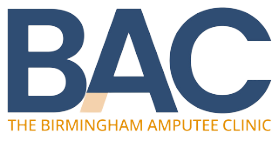What We Offer
Experienced Surgeon, Physio and Prosthetist

Primary and Revision Amputations
Lower limb amputations are carried out for a variety of reasons, the majority of patients we see at BAC have suffered major injuries to their limbs but other reasons to consider amputation may include tumours or complications of other surgeries. In many of these cases an amputation represents the best reconstructive option to restore function to the limb and maximise the quality of life of the patient.
Primary Amputations
Primary amputations at BAC are performed as a combined orthoplastic operation involving both consultant Orthopaedic and Plastic surgeons, in most cases the amputation is combined with nerve surgery (TMR or RPNI) to minimise the risk of complications associated with cut nerve ends. We believe that this multidisciplinary, orthoplastic, approach to surgery gives our patients the best possible outcome.


Revision Amputation
It is not uncommon that amputees have problems with their residual limb following amputation, in most cases these can be addressed by improved physiotherapy or limb-fitting. In a minority of cases further surgery may be indicated, at the BAC all such patients will have a multidisciplinary review to ensure all non-operative options have been considered before undertaking revision surgery. Revision surgery is again performed as an Orthoplastic procedure with a holistic approach to address all potential problems within the residual limb including the bone cuts, soft tissue coverage of the stump and associated nerve problems.
Direct Skeletal Fixation
Direct skeletal fixation (DSF), also known as osseointegration (OI), is an intervention for patients who have undergone an amputation which allows the patient to replace the normal socket type prosthesis with a device fitted directly onto a stem attached into the bone of the amputated limb. The procedure is aimed principally at patients who have undergone an amputation through the thigh bone, who struggle with the use of conventional socket type prosthesis.
About The Operation
The procedure for DSF is a major operation which requires 2 operations separated by a 3-4 week interval. At the first operation, the surgeons prepare the bone ends and the soft tissues around the amputation stump. A metal peg is inserted into the prepared bone. The peg is designed to fit tightly into the canal of the bone and is coated in a material which encourages the bone to grow onto the implant resulting in a secure fixation of the peg to the bone. The soft tissues are prepared to remove any excess tissue and dressings placed over the raw surface of the tissue. Patients are usually in hospital after the first operation for a period of approximately 1 week. During this time, patients begin to mobilise with the physiotherapy team and begin to gently put weight through the implant. After 5 days, the dressings are taken down and patients usually leave hospital after about 7 days.
The second operation usually takes place about 3-4 weeks after the first operation. It involves placing a skin graft onto the raw soft tissue area around the protruding peg. The skin graft is taken from the patients same limb or the other limb. This second procedure is undertaken as a day case procedure and patients usually go home the same day.
As important as the operation itself, is the rehabilitation. Patients undergoing DSF will be put in contact with providers of specialist rehabilitation services and following discharge will need to have in place a programme for rehabilitation.
Prices are on request



Painful Neuromas and Phantom Limb Pain
Peripheral nerves are severed during amputation, and/or traumatised at the time of injury. These nerve endings will attempt to regenerate. If the nerves do not have a target to regenerate towards, this can result in formation of a disorganised mass of nerve tissue called a neuroma. These can be very painful, affecting sleep and prosthetic fit.
Symptomatic neuromas that are not responsive to other treatments can be managed with targeted muscle reinnervation (TMR) surgery or surgical excision with regenerative peripheral nerve interface (RPNI) surgery.
Targeted Muscle Reinnervation (TMR)
Targeted muscle reinnervation (TMR) involves rerouting the severed or injured nerve(s) towards new muscle targets. This is achieved using microsurgical techniques to provide the nerve endings with viable muscle to innervate. This new target muscle allows the nerve to regenerate in an organised manner, instead of in a disorganised manner, which can lead to neuroma formation and phantom limb pain.
TMR can be performed at the time of amputation as a preventative measure, or in a delayed fashion after limb amputation when there are problems associated with neuroma formation and phantom limb pain.
TMR can also improve a person’s ability to control certain types of myoelectric prosthetics.
Regenerative Peripheral Nerve Interface (RPNI)
Regenerative peripheral nerve interface (RPNI) involves harvesting small muscle grafts and placing them over the severed nerve endings. This provides the nerve with target muscle to innervate. Similar to TMR surgery, this also encourages the nerve to regenerate in an organised manner, thus preventing neuroma formation and reducing phantom limb pain.
RPNI can be performed either at the time of amputation as a preventative measure, or after amputation in the scenario where symptomatic neuromas have developed.
Physiotherapy
As part of any treatment plan, the BAC will provide specialist physiotherapy advice, support and if required, hands on treatment to optimise your success. The BAC rehabilitation team strives for clinical excellence, delivered through research-based best practice, enabling you to become an accomplished, comfortable full-time prosthetic user.
Pain can come in the form of residual limb nerve pain, phantom limb pain and musculoskeletal. Recognising you as a whole and not just as an amputee is crucial to identifying and treating your pain. Pain is debilitating and can permeate all aspects of your life.
We believe that by understanding the physiological driver of your pain and treating the cause, we can help to reduce your pain, empowering you to enjoy life to the full. If you elect for surgery, the BAC Consultant Specialist Physiotherapist can provide pre-op, and post-op physiotherapy and rehabilitation. Or the BAC Consultant Specialist Physiotherapist can provide support to you and your local physiotherapy treating team to ensure we optimise your post-operative outcomes.


Prosthetics
The prosthetics treatment is provided by ProActive Prosthetics. ProActive is a private prosthetics clinic that was established over 20 years ago. Working with the BAC team, they provide the most clinically appropriate and functional prosthetic devices.
Socket technology is a the forefront of what ProActive do, following amputation or stump revision the provision of a correctly fitting prosthetic socket is crucial to a successful outcome. The aim will be to provide a good-fitting socket that can be used for the majority of the day with minimal amounts of discomfort. The other components of the leg such as the knee and foot are also critical to providing the best quality prosthetics, these are individually selected for each patient and set up to optimise the user’s walking pattern. This is extremely important with Osseintergation users, a poorly set up limb can result in a fall and compromise the surgery that has been carried out.
